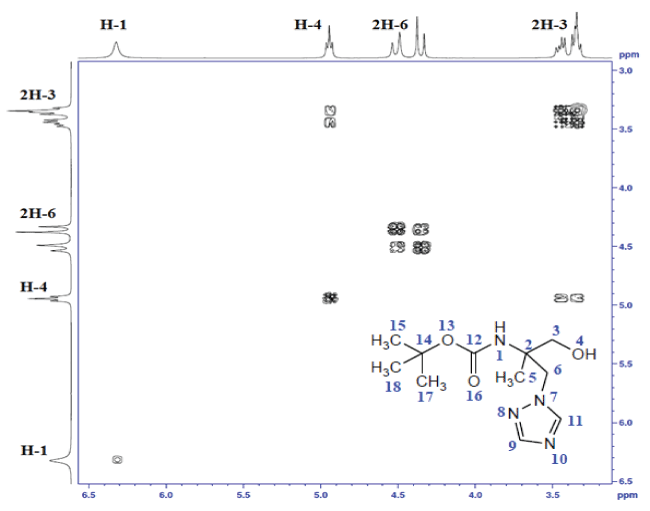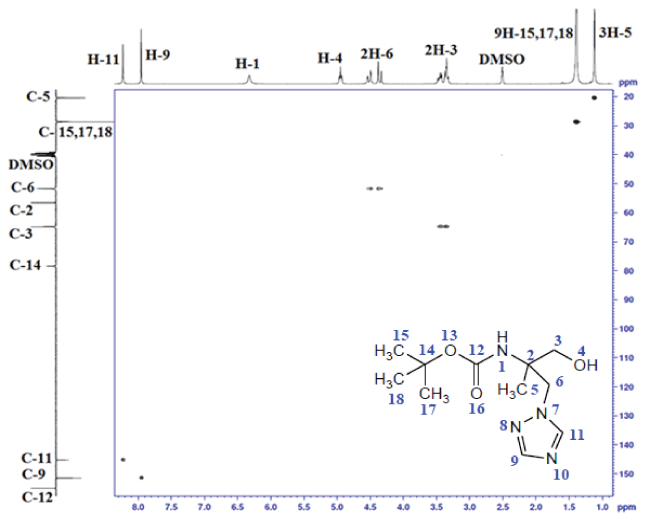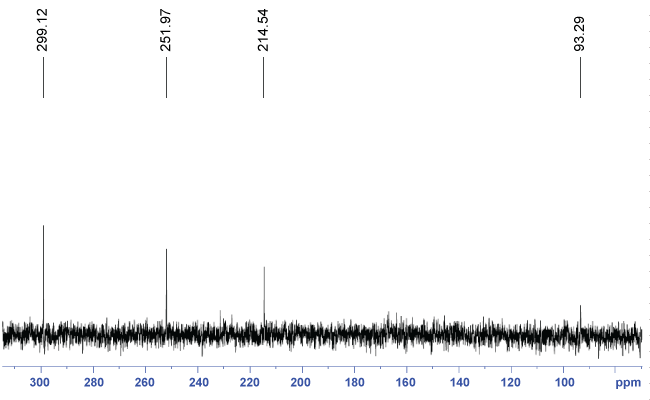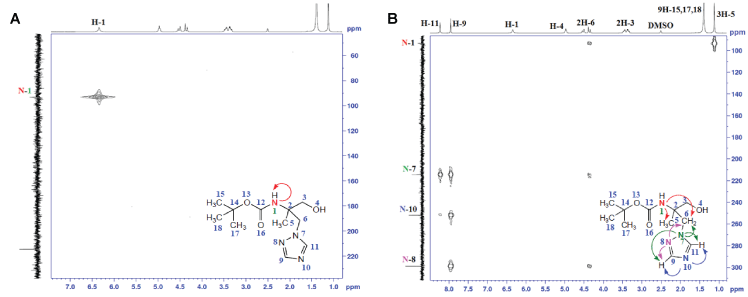1Laboratoire de Chimie Organique Fès, Faculté des Sciences Dhar El Mahraz, Université Sidi Mohamed Ben Abdellah, Morocco
2Cité de l'innovation, Université Sidi Mohamed Ben Abdellah, Fès, Morocco
*Corresponding author
Anouar Alami, Laboratoire de Chimie Organique Fès, Faculté des Sciences Dhar El Mahraz, Université Sidi Mohamed Ben Abdellah, Morocco, Tel: +212-661 796 480, Fax: +212-535 733 171, E-mail: alamianouar@yahoo.fr
Int J Exp Spectroscopic Tech, IJEST-1-004, (Volume 1, Issue 1), Review Article
Received: January 12, 2016
Accepted: March 12, 2016
Published: March 16, 2016
Citation: Aouine Y, Faraj H, Alami A, El-Hallaoui A, Akhazzane M (2016) Characterization of the Structure of tert-butyl[1-hydroxy-2-methyl-3-(1H-1,2,4-triazol-1-yl)]propan-2-ylcarbamate Using 2D Heteronuclear NMR Experiments. Int J Exp Spectroscopic Tech 1:004
Copyright: © 2016 Aouine Y, et al. This is an open-access article distributed under the terms of the Creative Commons Attribution License, which permits unrestricted use, distribution, and reproduction in any medium, provided the original author and source are credited.
Abstract
The alkylation of 1H-1,2,4-triazole with an O-tosyloxazoline derivative, followed by an oxazoline ring-opening reaction and protection of amine function, leads normally to obtain two regioisomers of β-aminoalcohols. After purification by column chromatography of the crude reaction product, only a single product is obtained. Hence, there is need of its identification by spectroscopic study.
Keywords
Oxazoline, 1H-1,2,4-triazole, β-aminoalcohol, 2D heteronuclear NMR experiments
Introduction
Triazoles constitute an important class of biologically active heterocyclic compounds that have received a great deal of attention since their discovery. Diverse compounds derived from 1,2,4-triazoles have a wide spectrum activities, including antimicrobial [1,2] and antibacterial properties [3,4], human antifungal agents [5], anticancer agents [6], antiviral [7], antitumor activity [8] and in agricultural science as potent fungicides, herbicides and insecticides [9,10]. Amino acids containing the 1,2,4-triazole moiety and their derivatives represent a well-known group of organic compounds also presenting biological activity. Thus β-(1,2,4-triazol-1-yl)-L-alanine is known as an important metabolite in plants of the fungicide myclobutanil [11-13] and β-(3-amino-1,2,4-triazol-1-yl)-L-alanine is a metabolite of the weed killer 3-amino-1,2,4-triazole [14].
Materials and Methods
NMR spectra (1H, 13C and 15N) were recorded on a Bruker AM 300 (operating at 300.13 MHz for 1H, at 75.47 MHz for 13C and at 30.41 MHz for 15N) spectrometer (Centre Universitaire Régional d'Interface, Fez-Morocco). NMR data are listed in ppm and are reported relative to tetra-methylsilane (1H, 13C).
Discussion
It is reported that afforded the corresponding 1- and 4-alkylated isomers, with prevalence of the N1-isomer [15-17]. Reaction of 1H-1,2,4-triazole with 1 and K2CO3, was carried out in the presence of a catalytic amount of tetrabutylammonium bromide in N,N'-dimethylformamide at 120°C for 12 hours. The previous reaction stage is followed by an oxazoline ring-opening reaction carried out in acidic medium. The aminoalcohol derivative 2, which is the aim of this paper, is obtained after addition of tert-butoxycarbonyl anhydride Boc to the intermediate product in a mixture of water/dioxane (1/2) at (0 < T < 5°C) in the presence of triethylamine [18]. Its structure was established on the basis of NMR spectroscopy (1H, 13C and 15N), in addition to MS data and elemental analysis.

The definite assignment the chemical shifts of protons, carbons and nitrogens of compound 2 are shown in table 1 and table 2 (Figure 1, Figure 2 and Figure 3).
Table 1. 1H (300 MHz) and 13C (75.47 MHz) NMR spectral data for 2 in DMSO-d6, including results obtained by homonuclear 2D shift-correlated 1H COSY and heteronuclear 2D shift-correlated HMQC (1JCH)a. Chemical shifts (δ, ppm) and coupling constants (J, Hz, in parenthesis)b.
Table 2. Listing of 15N (400 MHz) NMR spectral data for 2 inDMSO-d6, including results obtained by heteronuclear single quantum coherence shift-correlated (HSQC) and heteronuclear multiple bond coherence shift-correlated (HMBC).
This interaction 1H-15N has allowed us to make the following observations:
- A signal at 93.29 ppm attributed to the carbamate nitrogen N-1: correlation between CH3, CH2-triazole and the amidic nitrogen.
- A signal at 214.54 ppm attributed to the N-7 of the 1,2,4-triazole ring: correlation between the two triazole protons, CH2-triazole and N-7 nitrogen at position 1 of the 1,2,4-triazole ring.
- A signal at 251.97 ppm attributed to the N-10 of the 1,2,4-triazole ring: interaction between the two triazole protons and the N-10 located in the position 4 of the 1,2,4-triazole ring.
- A signal at 299.12 ppm attributed to N-8 of the 1,2,4-triazole ring: interaction between CH2-triazole, triazole proton H-9 and N-8 at position 2 of the 1,2,4-triazole ring.
Further, the analysis of 1H-15N HMBC spectrum of compound 2 confirms that the nucleophilic substitution reaction of 1,2,4-triazole and O-tosyloxazoline derivative 1 is carried out on the nitrogen in position 1 of the 1,2,4-triazole ring and its structure has been clearly identified (Figure 4).
Figures

Figure 1: Homonuclear 1H-1H 2D spectrum for compound 2 between 3 and 6.5 ppm.

Figure 2: Heteronuclear 1H-13C 2D spectrum for compound 2.

Figure 3: 15N NMR spectrum of the compound 2.

Figure 4: (A) 1H - 15N HSQC spectrum for compound 2; (B) 1H - 15N HMBC spectrum for compound 2.
References
-
Xu W, Song B, Bhadury P, Song Y, Hu D (2010) Synthesis and crystal structure of novel sulfone derivatives containing 1,2,4-triazole moieties. Molecules 15: 766-779.
-
Karabasanagouda T, Adhikari AV, Shetty NS (2007) Synthesis and antimicrobial activities of some novel 1,2,4-triazolo[3,4-b]-1,3,4-thiadiazoles and 1,2,4-triazolo[3,4-b]-1,3,4-thiadiazines carrying thioalkyl and sulphonyl phenoxy moieties. Eur J Med Chem 42: 521-529.
-
Tehranchian S, Akbarzadeh T, Fazeli MR, Jamalifar H, Shafiee A (2005) Synthesis and antibacterial activity of 1-[1,2,4-triazol-3-yl] and 1-[1,3,4-thiadiazol-2-yl]-3-methylthio-6,7-dihydrobenzo[c]thiophen-4(5H)ones. Bioorg Med Chem Lett 15: 1023-1025.
-
Foroumadi A, Soltani F, Moshafi MH, Ashraf-Askari R (2003) Synthesis and in vitro antibacterial activity of some N-(5-aryl-1,3,4-thiadiazole-2-yl)piperazinyl quinolone derivatives. Farmaco 58: 1023-1028.
-
Chen Q, Zhu XL, Jiang LL, Liu ZM, Yang GF (2008) Synthesis, antifungal activity and CoMFA analysis of novel 1,2,4-triazolo[1,5-a]pyrimidine derivatives. Eur J Med Chem 43: 595-603.
-
Holla BS, Poojary KN, Rao BS, Shivananda MK (2002) New bis-aminomercaptotriazoles and bis-triazolothiadiazoles as possible anticancer agents. Eur J Med Chem 37: 511-517.
-
Al-Soud YA, Al-Dweri MN, Al-Masoudi NA (2004) Synthesis, antitumor and antiviral properties of some 1,2,4-triazole derivatives. Farmaco 59: 775-783.
-
DemirbaÅŸ N, Ugurluoglu R, DemirbaÅŸ A (2002) Synthesis of 3-alkyl(aryl)-4-alkylidenamino-4,5-dihydro-1H-1,2,4-triazol-5-ones and 3-alkyl-4-alkylamino-4,5-dihydro-1H-1,2,4-triazol-5-ones as antitumor agents. Bioorg Med Chem 10: 3717-3723.
-
Crispino GA, Goudar JS (2001) Process for the preparation of a triazolinone herbicide. US Pat 6268506 B1.
-
Song BA, Hu DY, Zheng S, Huang RM, Yang S, et al. (2001) Synthesis and bioactivity of phosphorodithioate compounds containing 1,2,4-triazole. Chin J Org Chem 21: 524-529.
-
Arnold M, Evrard D, Leander J, Lodge D, Schoep D, et al. (1993) Tetrazole amino acids as competitive NMDA antagonists. Bioorg Med Chem Lett 3: 43-48.
-
Ebert B, Lenz S, Brehm L, Bregnedal P, Hansen JJ, et al. (1994) Resolution, absolute stereochemistry, and pharmacology of the S-(+)- and R-(-)-isomers of the apparent partial AMPA receptor agonist (R,S)-2-amino-3-(3-hydroxy-5-phenylisoxazol-4-yl)propionic acid [(R,S)-APPA]. J Med Chem 37: 878-884.
-
Ikegami F, Murakoshi I (1994) Enzymic synthesis of non-protein b-substituted alanines and some higher homologues in plants. Phytochemistry 35: 1089-1104.
-
Dunnill P, Fowden L (1965) The amino acids of seeds of the Cucurbitaceae. Phytochemistry 4: 933-944.
-
Bulger PG, Cotterell IF, Cowden CJ, Davies AJ, Dolling UH (2000) An investigation into the alkylation of 1,2,4-triazole. Tetrahedron Lett 41: 1297-1301.
-
Boukallaba K, Elachqar A, El Hallaoui A, Alami A, El Hajji S, et al. (2006) Synthesis of new alpha-heterocyclic alpha-aminophosphonates. Phosphor Sulfur Silicon 108: 819-823.
-
Bentama A, El Hadrami EM, El Hallaoui A, Elachqar A, Lavergne JP, et al. (2003) Synthesis of new alpha-heterocyclic alpha-aminoesters. Amino Acids 24: 423-426.
-
Aouine Y, Faraj H, Alami A, El-Hallaoui A, Elachqar A, et al. (2011) Simple and efficient synthesis of racemic 2-(tert-butoxycarbon-ylamino)-2-methyl-3-(1H-1,2,4-triazol-1-yl)propanoic acid, a new derivative of β-(1,2,4-triazol-1-yl)alanine. Molecules 16: 3380-3390.
